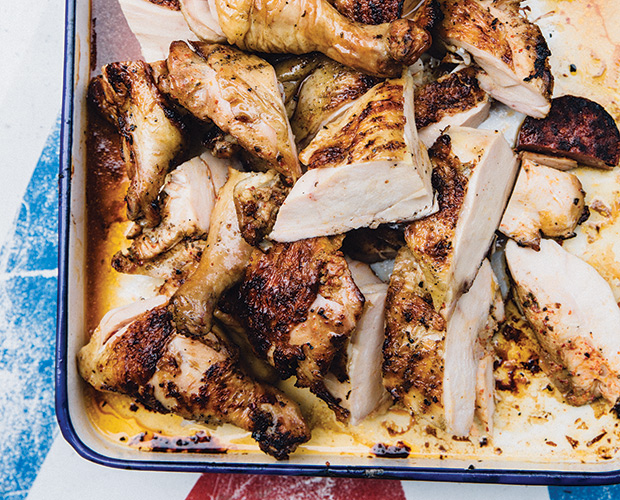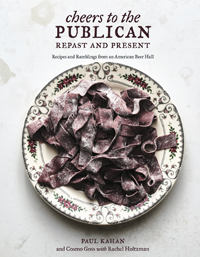Recipe
November 3, 2017
Restaurateur Paul Kahan’s Publican Chicken Recipe

Try this recipe for Publican Chicken from Paul Kahan’s new cookbook, Cheers To The Publican, Repast And Present.
 This is the most famous Publican dish, if there is such a thing. It has its roots in a Portuguese restaurant in Montreal, where this guy was grilling spiced and spatchcocked chicken over a charcoal grill — while smoking a cigarette — and then served it over a bed of French fries. Our interpretation of the dish includes cooking the chicken over wood, which adds a lot of flavor, and seasoning it with Espelette pepper (of course) and Mexican oregano, which I love for its almost minty flavor. But the real secret, aside from a squeeze of lemon at the end, is pre-salting and then marinating the chicken. It’s a technique I borrowed from Judy Rodgers, the late chef-founder of San Francisco’s Zuni Café, via Brian Huston—who worked for her before he came to The Publican. We salt the bird an entire day before it marinates, which allows the flavor to permeate and makes the fresh really tender, juicy, and zingy. It’s crazy good.
This is the most famous Publican dish, if there is such a thing. It has its roots in a Portuguese restaurant in Montreal, where this guy was grilling spiced and spatchcocked chicken over a charcoal grill — while smoking a cigarette — and then served it over a bed of French fries. Our interpretation of the dish includes cooking the chicken over wood, which adds a lot of flavor, and seasoning it with Espelette pepper (of course) and Mexican oregano, which I love for its almost minty flavor. But the real secret, aside from a squeeze of lemon at the end, is pre-salting and then marinating the chicken. It’s a technique I borrowed from Judy Rodgers, the late chef-founder of San Francisco’s Zuni Café, via Brian Huston—who worked for her before he came to The Publican. We salt the bird an entire day before it marinates, which allows the flavor to permeate and makes the fresh really tender, juicy, and zingy. It’s crazy good.
Directions
Yield: Serves 2 to 4
- First, clean the chicken. Rinse the bird under cold water, and dry with a paper towel.
- Now buttefly the chicken, which means taking out all but the drumstick and wing bones so the chicken will lay at as it cooks. Start by removing the wing tips at the first joint. Then turn the chicken vertically so its head (or at least where its head used to be) is on your cutting board. Holding on to the tail, run a sharp boning knife down the right side of the spine, from top to bottom. Repeat on the other side and remove the backbone.
- With the bird flat on the table, breast-side down and legs pointing away from you, make a small vertical cut in the white cartilage that runs over the breastbone. Bend both halves of the chicken backward at the cut, which will make the breastbone pop right through. Run your thumbs or index fingers down both sides of the breastbone, pull to separate it from the meat, and then pull the bone out. If it doesn’t come out easily, use your knife to loosen any remaining bone or cartilage.
- Finally, with the tip of your knife, make a slit along each thighbone to the knee joint. Use your fingers to move the flesh away from the bone and pull the bone out.
- Season the chicken on both sides, slightly less than you’d normally season if you were cooking right away. Put the chicken on a plate, cover it with plastic, and let it sit in the fridge overnight.
- The next morning, combine all the marinade ingredients in a large mixing bowl. Toss the chicken in there and gently rub the marinade into both the skin and the flesh. Let it sit for at least 1 hour and as many as 12 hours. (Put it back in the fridge if it’s going to sit for more than an hour and remove it from the fridge about an hour or two before you want to cook it.)
For Grill Chicken
- If grilling the chicken, build a fire on one side of a charcoal grill and let it burn down to embers. Alternatively, preheat your oven to 450°F.
- To grill the chicken: Cook the chicken skin-side down over indirect heat and positioned so the legs are just touching the direct heat. Cover the grill with the air holes open so you get good high heat. Cook for 6 minutes, then turn the chicken so the breasts are over the direct heat. Cook for another 6 minutes. Flip the bird over and do it again (another 6 minutes with the legs over direct heat, another 6 minutes with the breasts over direct heat).
- To tell if the chicken’s done, you can put a sharp paring knife in the breast and thigh (the thickest parts of the bird), hold it for a few seconds, then touch it to your arm. If it’s hot, it’s done. People will tell you that you shouldn’t be poking and prodding your meat to tell if it’s done, but I’m telling you that there’s no human being on this planet who can tell you if a whole chicken is done just by touching it. There’s nothing wrong with poking and prodding. Really. You could just use an instant-read meat thermometer instead; the chicken’s done at 160°F. Let the chicken rest for 5 minutes.
For Roast Chicken
- To roast the chicken in the oven: Add enough olive oil to coat the bottom of a big ovenproof skillet and heat over high heat until it smokes; then put the chicken, skin-side down, in the pan and cook over medium heat until a nice golden crust forms, about 5 minutes. Transfer the pan to the oven, without flipping the chicken over, and cook for 10 more minutes. Flip the chicken and cook for 8 minutes for a total of 23-ish minutes. Let the chicken rest for 5 minutes in the pan.
- Put the chicken on a carving board and hack it up. Or more specifically: Transfer the chicken to a carving board and cut it into 8 pieces. Start by cutting it in half from the neck to the tail. Next, remove each breast from the leg and thigh, then cut through each breast on the diagonal, dividing it into two pieces. Then cut the thighs from the legs at the knee joint.
- Squeeze lemon juice over the whole thing on the cutting board and be sure to save all the juices—it’s important to pour them over the chicken just before you serve it, especially if it’s over a mound of Frites.

